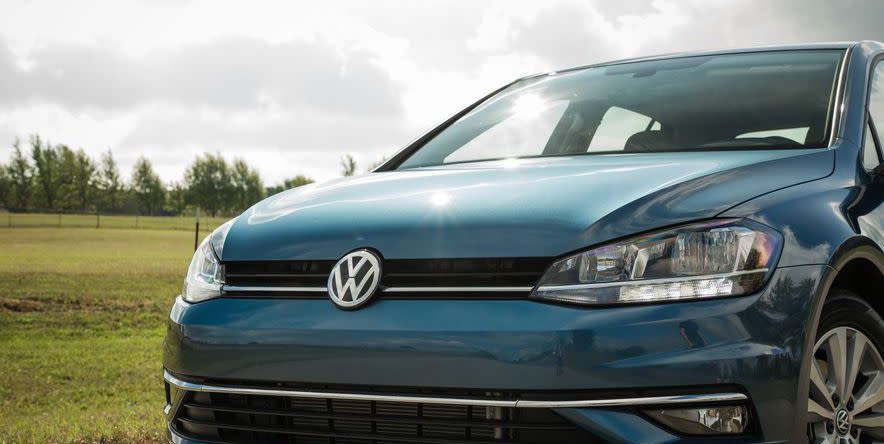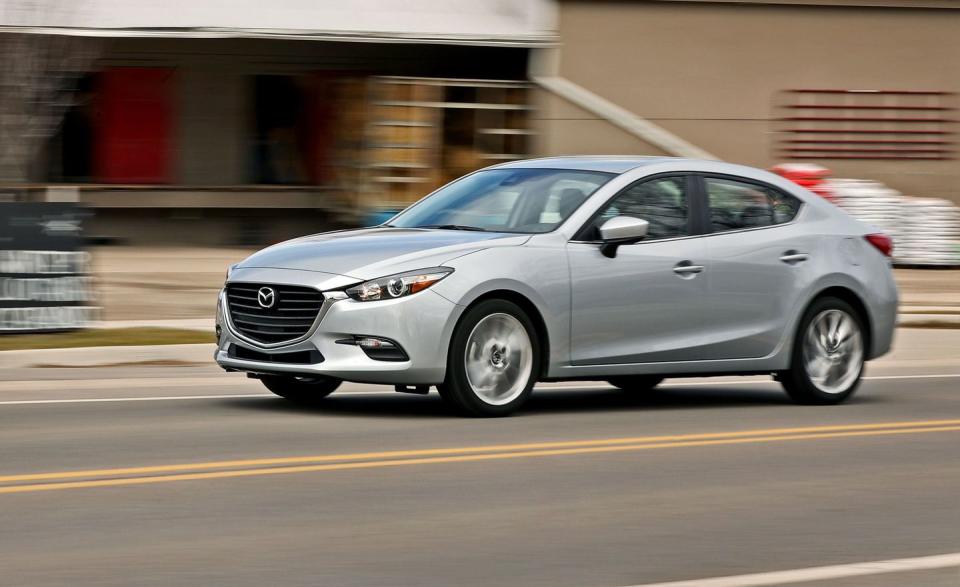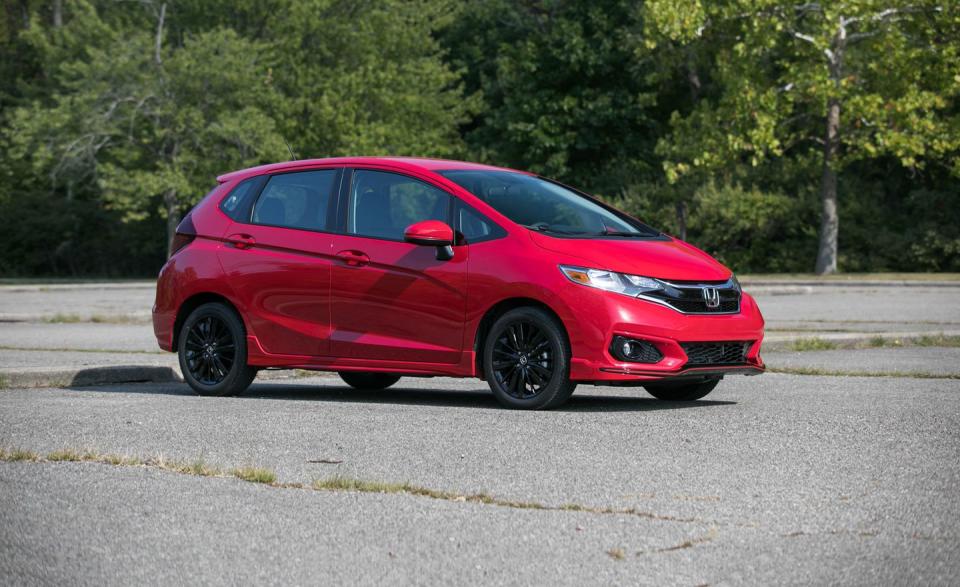5 Best First Cars for Teens

Few things unnerve parents quite like the thought of their kid behind the wheel. But it helps (a little) if that wheel belongs to a car that was purpose-built for safety.
All of our selections have a 5-star safety rating, a full complement of airbags, and a starting price around or below $20,000. That said, they’re hardly rolling bubble-mobiles.
The Volkswagen Golf doesn’t compromise an iota on performance-or anything, really. A plenty-powerful engine, nimble framework, and precise steering help make this hatchback the most well-rounded pick in this group.
Budget-conscious buyers should look at the Honda Fit. Quality construction, a roomy interior, all-new active safety features, and a starting sticker price of $17,080 make it a strong value.
For a car that looks as sporty as it feels, there’s the Mazda 3. Stylish, athletic lines give it a presence that suits the peppy powertrain. Exceptional safety and low price earn it a spot on this list.
BEST OVERALL
1. Volkswagen Golf

The Golf may look unassuming, with its jellybean body and small stature, but it’s one of our very favorite cars to drive. A frequent recipient of our 10Best Cars award, it expertly blends practicality, affordability, and real driving chops for a delightful package that demands almost no compromises from its owner.
A 170-hp turbocharged four-cylinder engine provides just the right amount of motivation for this little hatch, but the real stars of the show are the Golf’s dynamic, nimble chassis and its always accurate steering, which make this car as rewarding to swerve through harsh corners as it is to slide improbably large cargo through the wide hatchback.
Sure, big brother GTI has more power and better performance numbers, but for the everyday teen with a new job and new freedom, it’s hard to do better than a Golf.
Styling and Appearance
We have used many words to describe the Golf, but “beautiful” is not one of them. The LED taillights and daytime running lights (new for 2018) look sharp. But the Golf, despite its many charms, is no looker.
However, we’ll trade appearances for a compact, utilitarian package any day.
Volkswagen has attempted to sharpen this functional compact’s looks in recent years, with angular headlights and an angled rear window. Its small proportions, short hood, and large windows all contribute to the Golf’s daily livability.
The interior is plain but comfortable and functional, perfectly embodying Volkswagen’s design ethos. You’ll never feel pampered, but you won’t be subjected to any ill-conceived design themes, either.
Value and Warranty
The Golf starts at $20,715, and for buyers who are looking to keep the impact on their bank account minimal, the base Golf is a sufficient package.
We like the engagement of the Golf’s five-speed manual transmission, but we also enjoy the quick-shifting, sure-footed six-speed automatic. Both are paired with an eager 170-hp turbocharged 1.8-liter four-cylinder.
The Wolfsburg trim carries significantly more content for a $1700 premium, and it’s worth the upgrade if you can swing it. The extra scratch will net drivers several enhancements, including:
Leatherette seating surfaces with heated front seats
Forward-collision warning with automated emergency braking
Blind-spot monitoring
Rear cross-traffic alert
The final tally for a manual Golf Wolfsburg is $22,415.
The Golf’s warranty is impressive in this class, matching or besting its competitors in most categories. Longer limited and powertrain warranties top the offerings of most competitors in this set (both cover 6 years/72,000 miles). One dislike: No complimentary scheduled maintenance.
Safety
The Golf received excellent ratings from both major ratings agencies, and coveted pieces of active safety equipment (automated emergency braking, adaptive cruise control) are available in upper trim levels.
The 2018 Golf earned a five-star rating from the National Highway Traffic Safety Administration (NHTSA), but just missed maintaining its Top Safety Pick from the Insurance Institute for Highway Safety (IIHS) after scoring slightly lower in the front crash prevention category.
BEST MIDSIZE CAR
2. Toyota Camry

The Toyota Camry has been the best-selling passenger car in America for 15 straight years, but that doesn’t mean it has also been the best family sedan-quite the contrary.
We’ve spilled plenty of ink maligning the previous-generation Camry. But, now that we’ve spent ample time behind the wheel of this new model, we’re happy to report that the Camry is finally a car we want to drive. For the first time in many years, it’s a compelling entry in the family-sedan class, one that can compete on more than its reputation for flawless reliability and great resale value.
Among the new model’s assets: the most fuel-efficient gasoline engine we’ve ever tested, a hybrid that scores the highest EPA ratings of all family-sedan rivals, much improved ride and handling, and nicer interiors.
And there’s more: Toyota’s commitment to providing heaps of standard active safety technology holds firm. Sadly, Apple CarPlay and Android Auto still aren’t on the menu at any price, and there are several other minor shortcomings. Still, there’s no mistaking that the Camry has been reborn.
Styling and Appearance
The Camry got a big attitude adjustment in its redesign. Its new, more aggressive mien may not be for everyone, but it certainly helps the Camry to stand out in a crowd.
A little more than an inch longer and fractionally lower and wider than the 2017 Camry, the new version has a substantial road presence but still slips easily into parking spaces and through traffic.
The split-level, catamaran-inspired grille gives the Camry a wide-open maw that’s reminiscent of a whale shark in search of krill. In L, LE, and XLE models, the bottom half of the grille is finished with a series of horizontal bars that look more than a little like venetian blinds. The sportier SE and XSE models have a black mesh lower grille instead, and the XSE has an available color-contrasting black roof package, if you’re into that kind of thing.
As for the interior, there’s a serious gap in material quality between the entry-level and more expensive models, and the redesigned center stack left some of wanting more from its uninspired design.
The trim pieces in our SE test car were plasticky, beige, and wouldn’t look out of place in a dentist’s office. Stepping up to the top XLE or XSE trim nets buys buttery leather seats-expensive-looking quilted leather in the XLE-plus cushy door trim instead of hard surfaces and a larger infotainment screen in the dashboard.
We don’t begrudge young drivers for deciding on the middle trims and pocketing the extra money, but beware of the significant discrepancy in interior ambience between the top and lower trims.
Value and Warranty
We thoroughly enjoy driving the V-6–powered Camrys, but with a $5950 premium compared with four-cylinder models, it’s hard to justify the cost, especially when the four-cylinder is so efficient. We’d choose the $26,095 SE four-cylinder Camry, with standard features that include:
Forward-collision warning, lane-keeping assist, and adaptive cruise control
Automatic climate control
A leather-trimmed steering wheel with paddle shifters
To that, we’d add the $2125 option package that includes a power sunroof, blind-spot monitoring, rear cross-traffic alert, and passive keyless entry.
As usual, Hyundai is the purveyor of the best warranty in this competitive set, but Toyota holds its own with two years of complimentary scheduled maintenance.
Safety
The 2018 Toyota Camry earned a five-star NHTSA rating and the Top Safety Pick+ designation from IIHS.
We applaud Toyota’s decision to make collision-avoidance technology standard across its lineup. Features like forward-collision warning, adaptive cruise control, and lane-keeping assist appear even in the entry-level $24,390 Camry L. Alas, while blind-spot monitoring and rear cross-traffic alert are standard only in the top-level XSE and XLE trims.
BEST SPORTS CAR
3. Mazda 3

What makes the Mazda 3 one of our favorite cars-not to mention a multi-time 10Best Cars winner? Its winning formula is simple and continues to win us over: sharp looks, a near-premium interior, and sublime driving dynamics.
The 3 is available in both sedan and hatchback body styles, with one of two efficient engines and either a slick-shifting six-speed manual or a satisfying six-speed automatic transmission. Neither powertrain will embarrass a competitor in a stoplight drag race, but the 3 is a star when charging curvy back roads.
As a daily driver, it’s practical, comfortable, and stylish. Blend those virtues with its driving pleasure and it’s no wonder the 3 finds itself at the top of our list for teen drivers.
Styling and Appearance
Mazda’s entire lineup is handsome, and the revisions made to the 3 for 2017 brought additional crispness to its taut, athletic lines, which look particularly fetching on the profile of the hatchback. While many of its competitors are either overstyled or downright boring to behold, the 3 strikes a beautiful balance of aesthetics that lend it greater street presence than most small cars.
A new, dark-colored wheel design graces the silhouette of Touring trims for 2018. Otherwise, the Mazda 3’s handsome looks mirror that of the 2017 lineup.
Value and Warranty
Our favorite trim is the Grand Touring hatchback with a six-speed manual, starting at $24,770; that’s $750 more than a similarly optioned Mazda 3 sedan, but the hatchback’s extra versatility is worthy of the upcharge.
Standard equipment on the GT trim includes 18-inch wheels, rain-sensing wipers, power and heated exterior mirrors, dual-zone automatic climate control, a head-up display, and an upgraded Bose nine-speaker stereo system. It also includes Blind-spot monitoring with rear cross-traffic alert.
We’d opt for the $1600 Premium Equipment package and its navigation system, adaptive LED headlights, a heated steering wheel, and the aforementioned active safety technologies. The final outlay comes to $26,370, which, combined with the 3’s other attributes, makes it highly attractive for the money.
Mazda’s warranty is good, but it’s not as comprehensive as competitors such as Hyundai, with its 10-year or 100,000-mile powertrain coverage, or Chevrolet, with its two free maintenance visits over the course of two years or 24,000 miles. But of note for those in the Snow Belt, which might as well be called the Salt Belt, Honda matches Mazda’s terms on corrosion protection. But Chevy, Hyundai, and Volkswagen all have more extensive coverage in this area.
Safety
The Mazda 3 scores very well with safety agencies, despite having a rather modest suite of active safety and convenience features. Both the sedan and the hatchback received IIHS’s highest Top Safety Pick+ honor for 2018, and both get five stars from NHTSA.
Mazda has made some changes to its active safety technologies for 2018. Automated emergency braking is now standard across the lineup, and the i-Activsense suite of advanced features-lane-keeping assist, automatic high-beam headlamps, adaptive cruise control, and more-are now a part of the Premium Equipment package on Grand Touring models rather than as a standalone $1100 option package.
BEST ALL-WHEEL DRIVE
4. Subaru Impreza

Standard all-wheel drive, fantastic safety ratings, and a comprehensive suite of infotainment features make the Subaru Impreza a compelling choice in the compact-car marketplace.
A handsome but subdued exterior style and a durable, businesslike cabin give the Impreza broad appeal, and its predictable and athletic frame provides driving enjoyment for those who care. If only its engine-a 152-hp 2.0-liter flat-four-made more power and were paired with a better transmission.
Fuel efficiency and acceleration performance both suffer, and no one will enjoy rowing the notchy shifter that comes with the standard five-speed manual transmission. Focusing on the equipment and the all-weather confidence, the Impreza is a car we’re happy to recommend, but it would still need an inspired powertrain to achieve greatness.
Styling and Appearance
The new Impreza’s design is an evolution of its predecessor. Flowing lines replace the former car’s slab sides, while a more expressive front end provides the small Subaru with added character. The result is a handsomer-if still ultimately forgettable-Impreza.
The Impreza’s interior emphasizes ergonomic friendliness. Simple secondary controls and minimal blind spots make for an intuitive and comfortable behind-the-wheel experience.
Value and Warranty
Moving one rung up from the base 2.0i model is the midrange Premium trim, which starts at $22,155. It’s our pick of the lineup and comes standard with comfort and convenience features such as:
All-wheel drive
Heated seats and a windshield wiper de-icer
Steering-wheel-mounted paddle shifters
Selecting the hatchback body style adds $500 to our Impreza Premium, and we’d also select the $1395 EyeSight Driver Assist Technology package, which includes adaptive cruise control, automated emergency braking, blind-spot monitoring, lane-departure warning, lane-keeping assist, and fog lamps. Our Impreza wears a price tag of $24,050.
The Impreza’s warranty is average for this group of competitors. Buyers who value extensive warranty coverage would be wise to look at the Hyundai Elantra or the Kia Forte.
Safety
Every Subaru Impreza earns top marks in crash tests conducted by both NHTSA and IIHS. The Top Safety Pick+ rating from IIHS is based on vehicles equipped with Subaru’s EyeSight suite of active safety features, which is optionally available on Premium, Limited, and CVT-equipped Sport models.
The 2017 Impreza’s crash-test results, available features, and safety ratings all carry over unchanged to 2018. Premium, Sport, and Limited trims now feature headlamps that turn on when the windshield wipers are actuated.
Subaru’s EyeSight suite of safety technology (automated front braking, adaptive cruise control, lane-keeping assist, and lane-departure warning) is available on Premium, Limited, and CVT-equipped Sport models.
Opting for EyeSight also adds a blind-spot monitoring system. Blind-spot monitoring can be optioned separately from EyeSight on Premium and Sport trims, regardless of transmission. Opting for EyeSight on the top-spec Impreza Limited also adds automatic high-beam headlights and a rear automated emergency braking system.
BEST BUDGET BUY
5. Honda Fit

Honda’s Fit is aptly named: You can fit much more stuff inside it than in any other subcompact thanks to its boxy shape and multi-way folding rear seats.
It also is a strong value, with class-competitive refinement and build quality with a $17,080 base price. The 2018 model adds active safety features such as adaptive cruise control, lane-keeping assist, and automated emergency braking as optional or standard equipment on every trim level, further distancing the Fit from its humble competitors.
Although you can get the Fit with a manual gearbox, it’s at best pleasant to drive-which is a bit of a disappointment considering that the previous-generation model was more engaging while being equally practical. But if impressive interior space and versatility in a tiny package are what you’re looking for, the Fit is still a car we highly recommend.
Styling and Appearance
The Fit’s appearance offers refreshing honesty. Its minivan-like boxiness is a dead giveaway to the hatchback’s cargo-hauling dexterity, while its relatively small 15- and 16-inch wheels and tiny footprint make no effort to fake the Fit into a richer vehicle class.
The interior is another story: Cleanly styled and assembled well from quality materials, the Fit’s interior shines among the best in the segment. Factor in its spaciousness-both literal and figurative, thanks to its square shape and large, airy windows-and the Fit’s interior is a pleasant place to be.
Value and Warranty
Honda’s Fit provides basic transportation, plain and simple, so we see no reason to opt for anything beyond the lower trim levels. The new-for-2018 active safety features are optional on every model-although on every version save for the EX, they’re paired with a continuously variable automatic transmission (CVT).
For manual transmission plus automated emergency braking, adaptive cruise control, lane-keeping assist, and forward-collision warning (and a sunroof), the $19,050 EX manual is a good choice. Beyond that, the Fit begins to overlap with the considerably larger, more powerful, and comfier Civic hatchback lineup.
Honda’s three-year or 36,000-mile limited warranty is industry average, and the Fit expands on it with a strong five-year or 60,000-mile powertrain warranty and three years or 36,000 miles of roadside assistance.
Safety
The Fit may be small, but it’s hardly ill prepared for a crash. Good scores from NHTSA and IIHS are major positives, as well as its newly available (and rare for this class) automated emergency braking, lane-departure warning, adaptive cruise control, and forward-collision warning.
While the Fit earned NHTSA’s top score (5 stars), IIHS did not subject the Fit to its front small-overlap crash testing, which is required to be considered for a Top Safety Pick or Top Safety Pick+ rating. Even if the Fit had aced those tests, it would have been disqualified for top IIHS honors by its headlight performance, which the agency must rate as Acceptable or Good. But for its value, the Honda Fit is a safe buy for teen drivers.
('You Might Also Like',)

 Yahoo Finance
Yahoo Finance 